Brandenburg, Germany, is home to a vibrant bird population. It is considered one of Europe’s most important bird habitats and is home to many rare and endangered species.
The landscape and climate of Brandenburg are diverse, providing a wide range of bird habitats. The region’s wetlands, forests, and grasslands all host a variety of bird species.
There are over 200 species of birds in Brandenburg, many of which are migratory birds that come to the area in the spring and summer months. Some of the most notable species include white storks, Eurasian cranes, and many species of waterfowl.
With its vast array of habitats and diverse population of birds, Brandenburg is an essential stop along the migratory flyway for many species.
24 Birds to Watch in Brandenburg
Brandenburg is a state in Germany that is rich in natural beauty and biodiversity. It has more than 3000 lakes and 33000 kilometers of rivers and streams, and 35 percent of its area is covered by forests. It is also home to a variety of birds, some of which are rare or endangered.
Here are 24 birds that you can watch in Brandenburg, and tell you where and when to find them.
1. Osprey
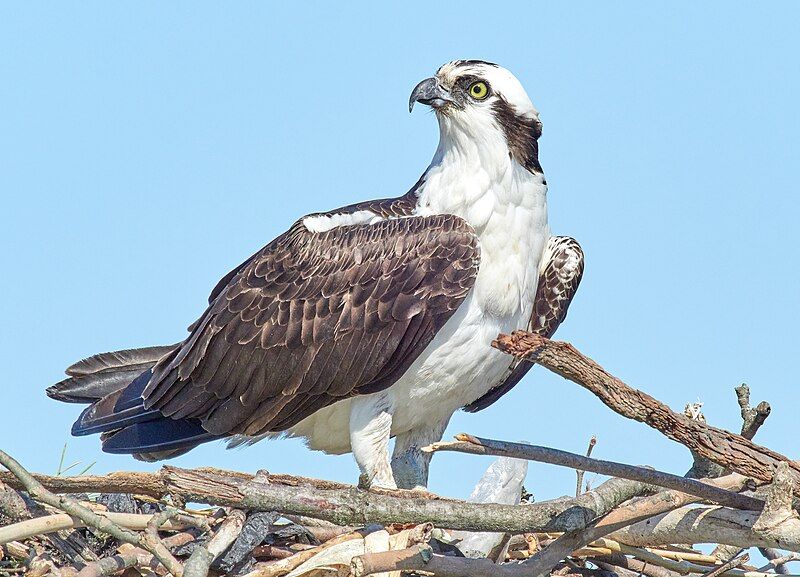
The Osprey is a large, diurnal bird of prey with a wide range. It is an impressive raptor with a length of over 60 cm and a wingspan of 180 cm. It has a brownish color on the top of its body, while its head and underside are primarily grey.
The Osprey is also known by several other names, such as sea hawk, river hawk, and fish hawk, as it primarily feeds on fish. They are highly successful hunters, using their powerful talons to snatch fish from the water and carry them away to enjoy their meal.
The Osprey is an impressive species easily recognizable due to its size, unique coloration, and distinctive fishing behavior.
| Kingdom | Animalia |
| Phylum | Chordata |
| Class | Aves |
| Order | Accipitriformes |
| Family | Pandionidae |
| Genus | Pandion |
| Species | P. haliaetus |
2. Great Egret
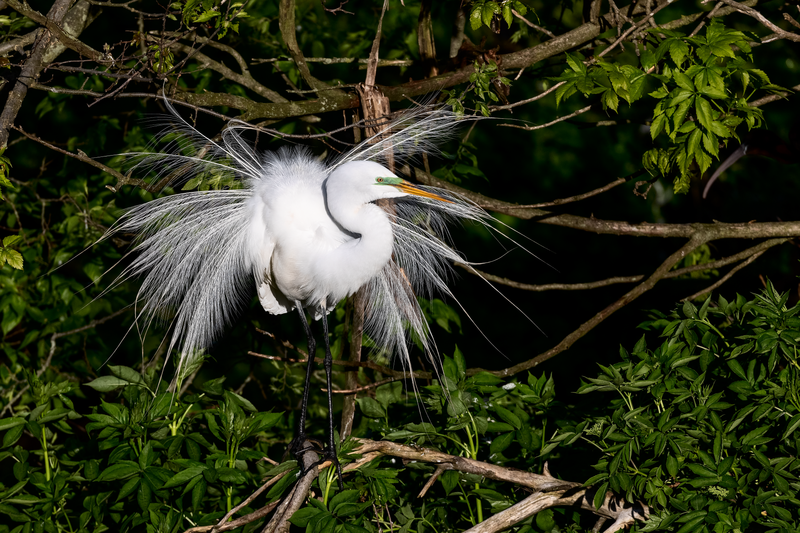
The great egret is a large bird that is widely distributed across the world. It is also known as the common egret, large egret, great white egret, or great white heron.
It can be found in four different subspecies in different parts of the world: Asia, Africa, the Americas, and southern Europe. The great egret has been spotted in more northern parts of Europe in recent years, showing its range expanding.
The great egret is a majestic bird that stands tall and proud with its long neck and wingspan. It has a white plumage often highlighted by its yellow bill and black legs.
This species is known for its beauty and grace, gracefully gliding through the air and standing atop branches. It is an essential species in many ecosystems, as it is a top predator that feeds on fish, amphibians, and other small prey.
The great egret plays a vital role in many cultures, with its feathers used in ceremonies and its image appearing in many artworks and literature. Its population is currently stable but still threatened by human development, habitat loss, and climate change.
We must protect this species and its habitats from destruction so that it may continue to thrive worldwide.
| Kingdom | Animalia |
| Phylum | Chordata |
| Class | Aves |
| Order | Pelecaniformes |
| Family | Ardeidae |
| Genus | Ardea |
| Species | A. alba |
3. Common Crane
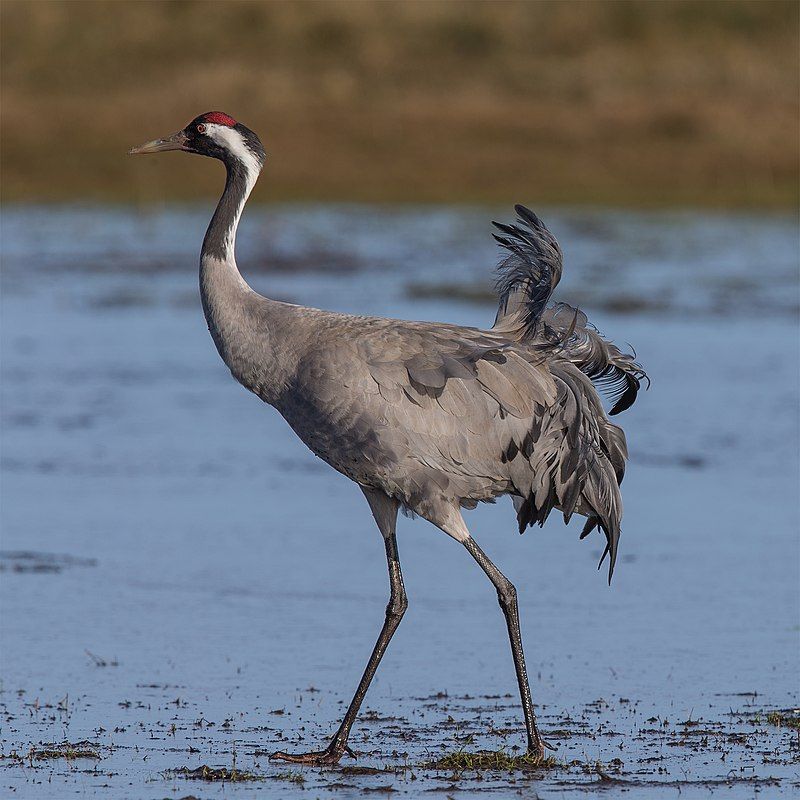
The standard crane is a species of bird that belongs to the family Gruidae, commonly known as cranes. It is one of the two crane species found in Europe, the other being the demoiselle crane.
The standard crane is a medium-sized bird with a wingspan of up to 2.7 meters. It is found mainly in the western part of the continent, but there is also a population of Siberian cranes that can be found in the far eastern regions of Europe.
These birds are typically found in wetland habitats such as marshes, lakes, and rivers. Common cranes migrate during the winter when food is scarce, often traveling great distances for food and suitable breeding grounds.
The birds are also known to congregate in large flocks, which can number in the hundreds. They are omnivorous, meaning that they feed on both plants and animals.
| Kingdom | Animalia |
| Phylum | Chordata |
| Class | Aves |
| Order | Gruiformes |
| Family | Gruidae |
| Genus | Grus |
| Species | G. grus |
4. Mallard
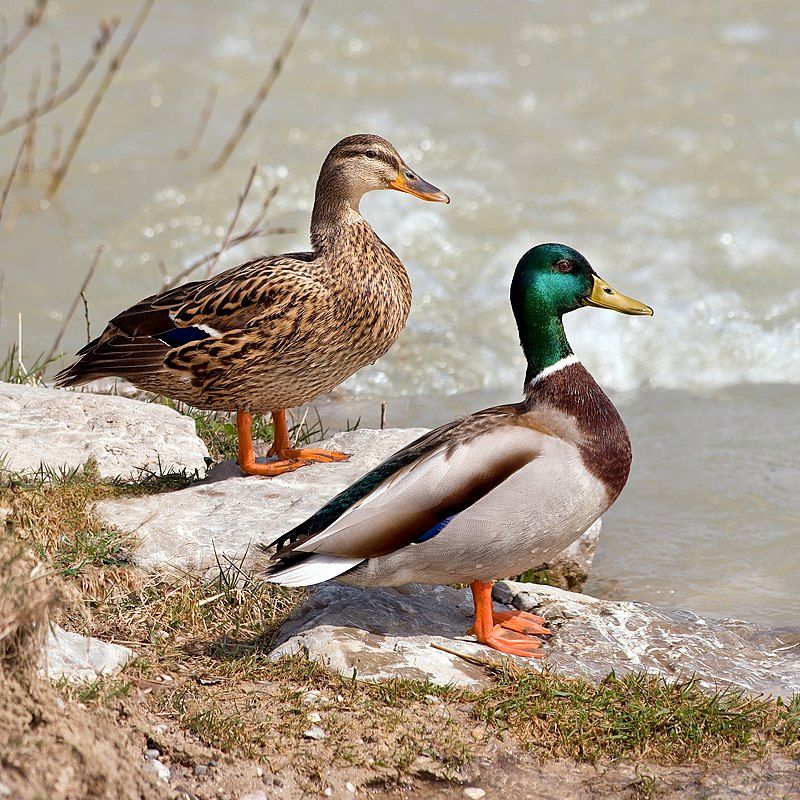
The mallard or wild duck is a species of dabbling duck that is found all over the world. It is native to temperate and subtropical regions of the Americas, Eurasia, and North Africa but has since been introduced to several other countries.
New Zealand, Australia, Peru, Brazil, Uruguay, Argentina, Chile, Colombia, the Falkland Islands, and South Africa are all countries the mallard has been introduced to. Mallards are generally considered a hardy species, as they can survive in various climates and habitats.
They are found in fresh and saltwater environments, from ponds and lakes to marshes and coastal areas.
The mallard is also highly adaptable, allowing them to thrive in many different environments. The mallard is one of the most common ducks in the world and one of the most widely studied.
This is due to its extensive range and ability to live in many habitats. Studies of the mallard have revealed that it is a highly social species, living in large flocks and often engaging in cooperative behavior.
It is also highly adaptive, quickly adjusting to changes in its environment. The mallard is an important species to humans, providing various ecological services.
Its presence in freshwater habitats helps control aquatic insect populations, which can be a nuisance for people. Additionally, mallards are essential to the hunting community, as they are often used for sport.
| Kingdom | Animalia |
| Phylum | Chordata |
| Class | Aves |
| Order | Anseriformes |
| Family | Anatidae |
| Genus | Anas |
| Species | A. platyrhynchos |
5. Grey Heron
The grey heron is a majestic bird in many parts of the world. It has a long body, long legs, and a broad wingspan, allowing it to soar gracefully through the sky.
This species belongs to the heron family Ardeidae and is in temperate areas of Europe, Asia, and Africa. The grey heron is a resident species in many regions, meaning it stays in the same area year-round.
However, in colder climates, some populations migrate south for the winter. This annual migration helps them find food and a more hospitable environment to survive. The grey heron is an opportunistic feeder, eating any small animal to swallow.
Its diet includes fish, frogs, small mammals, insects, and other aquatic creatures. The heron will stand motionless in shallow water to catch these prey items, waiting for the perfect moment to strike. Once it spots its meal, it will swoop and grab its meal using its long beak.
The grey heron is an integral part of the ecosystem, helping to maintain a healthy food chain balance. Its presence also helps to keep insect populations in check, helping to prevent agricultural damage.
The heron’s graceful movements and beautiful plumage make it a favorite among bird watchers. The grey heron is a fascinating species that has adapted to its environment in various ways.
Its ability to inhabit different regions of the world and its impressive hunting skills make it a remarkable bird worthy of admiration.
| Kingdom | Animalia |
| Phylum | Chordata |
| Class | Aves |
| Order | Pelecaniformes |
| Family | Ardeidae |
| Genus | Ardea |
| Species | A. cinerea |
6. Mute Swan
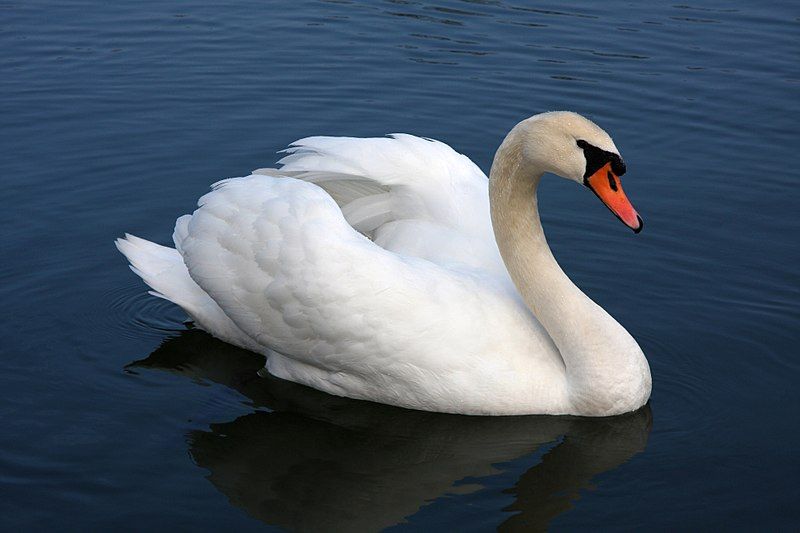
The mute swan belongs to the Anatidae of the waterfowl family. It is native to many parts of Eurasia, from Europe to Siberia and even Africa.
The mute swan is one of the most recognizable species of swan, as it is the only swan species to lack a vocal call. Instead, it communicates with visual displays such as neck stretching and head nodding.
As an aquatic bird, it is adapted to freshwater and coastal habitats, where it can be found in lakes, rivers, estuaries, and marine coasts. It is also a famous ornamental bird, often kept in parks and public waterways.
The mute swan has white plumage with an orange bill and legs, which make it easily distinguishable. It has a large wingspan and can fly long distances to be found on different continents.
| Kingdom | Animalia |
| Phylum | Chordata |
| Class | Aves |
| Order | Anseriformes |
| Family | Anatidae |
| Genus | Cygnus |
| Species | C. olor |
7. Greater White-fronted Goose
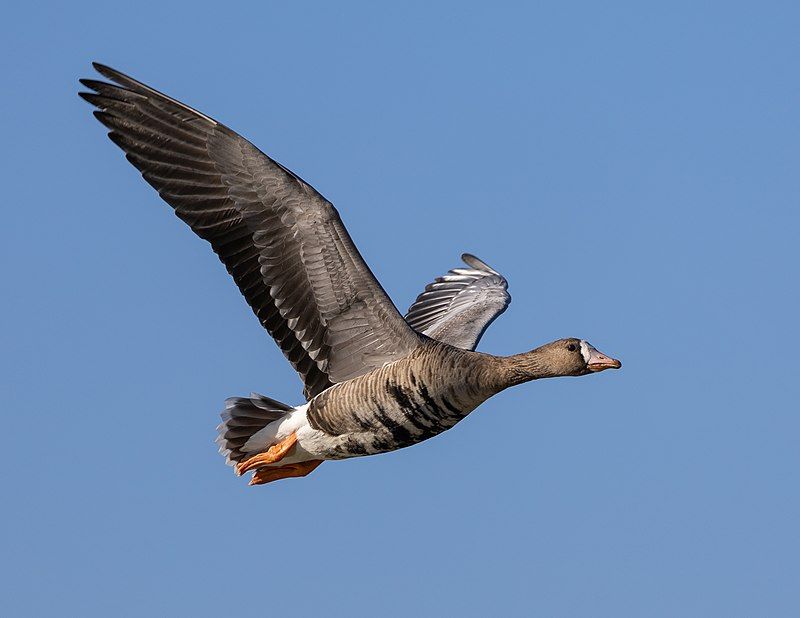
The greater white-fronted goose is a variety that is closely related to the smaller, lesser white-fronted goose. Its name was derived from the white feathers that border the base of its bill.
This white patch gave the species the Latin name albifrons, a combination of the words “albus,” meaning white, and “frons,” meaning forehead.
This goose species is found in many regions worldwide but is especially prevalent in the Arctic and sub-Arctic areas. It is a medium-sized goose with a wingspan of around 75 cm and a body length of around 50 cm.
The greater white-fronted goose has a light grey body with a blackish-brown head and neck. Its bill and legs are bright yellow, and its wings are tipped with white. The greater white-fronted goose is an omnivore and eats plant and animal material.
It feeds on grasses, grains, insects, mollusks, and other aquatic animals. The greater white-fronted goose is an essential species for conservation, as it is listed as near threatened on the IUCN Red List of Endangered Species.
Protecting and preserving their habitats is essential to ensure that this species can continue to thrive.
| Kingdom | Animalia |
| Phylum | Chordata |
| Class | Aves |
| Order | Anseriformes |
| Family | Anatidae |
| Genus | Anser |
| Species | A. albifrons |
8. Grebes
Grebes are one of the many bird species found in the order Podicipediformes. These aquatic diving birds are widely distributed throughout freshwater habitats, though some species may travel to marine habitats for migration and winter.
Grebes are known for their ability to fly, although a few flightless species can be found in stable lakes. These flightless grebes are rare and are primarily seen in environments where human activity does not disturb them.
They are typically relatively small and have a streamlined body that allows them to dive underwater quickly and gracefully. Grebes have various colorful feathers, ranging from gray and brown to vibrant blues and greens.
They also have a unique courtship display, where the male presents the female with a fish or other small prey to win her affection.
Grebes are an essential part of the aquatic food web and play a crucial role in maintaining the health and balance of their environment.
| Kingdom | Animalia |
| Phylum | Chordata |
| Class | Aves |
| Clade | Mirandornithes |
| Order | Podicipediformes |
| Family | Podicipedidae |
9. Black Stork
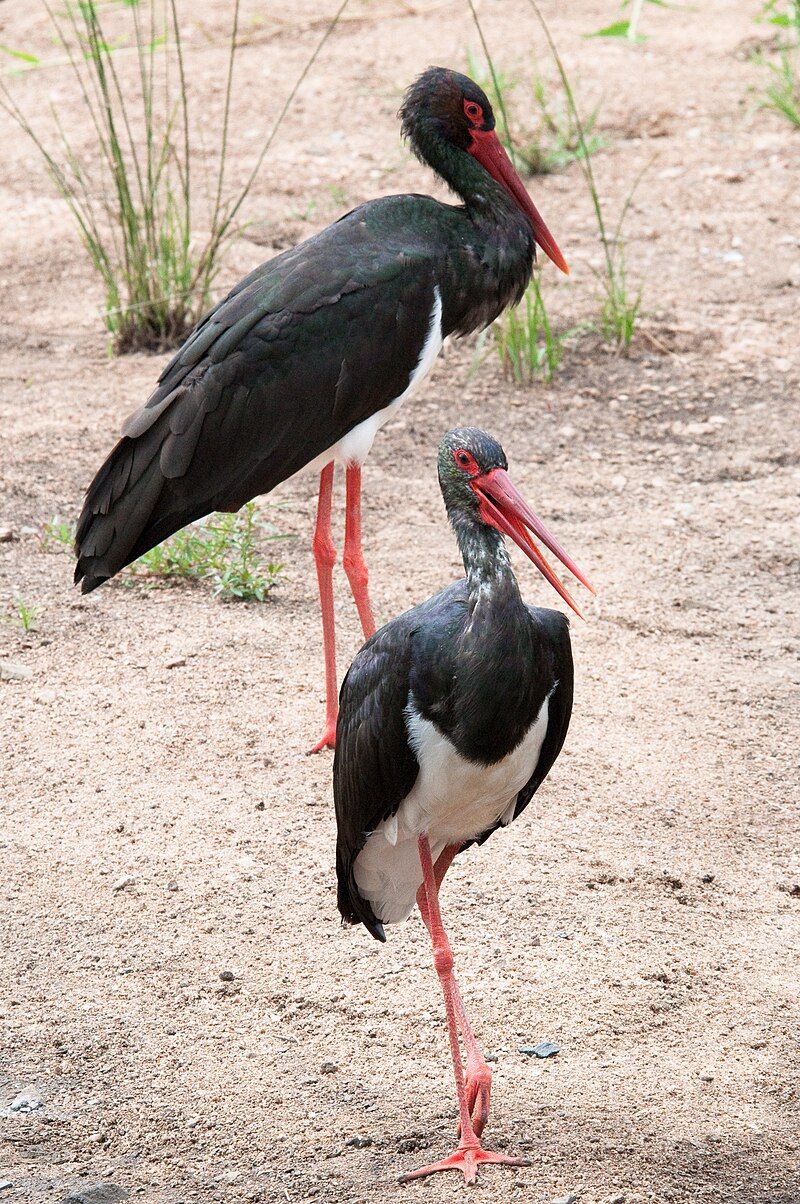
The black stork is a large bird species native to Europe, Asia, and Africa. It belongs to the family Ciconiidae and is one of the larger stork species. Swedish naturalist Carl Linnaeus first described the black stork in the 10th edition of his Systema Naturae.
This edition was published in 1758 and is considered the starting point of modern taxonomy. The black stork is a large bird, measuring up to 95 cm in length with a wingspan of up to 135 cm.
It has a dark gray or black-tinted plumage with white on the wings and tail and bright red legs and bill. The black stork is often seen wading in shallow waters, such as marshes and swamps, as it hunts for aquatic prey.
It also feeds on small reptiles, amphibians, fish, and insects. The black stork is an essential species in the wetland ecosystems of its range.
It is listed as a species of most minor concern on the International Union for Conservation of Nature’s Red List of Threatened Species. However, its population has declined in some parts of its range due to the destruction of wetlands and other human activities.
| Kingdom | Animalia |
| Phylum | Chordata |
| Class | Aves |
| Order | Ciconiiformes |
| Family | Ciconiidae |
| Genus | Ciconia |
| Species | C. nigra |
10. Common Kestrel
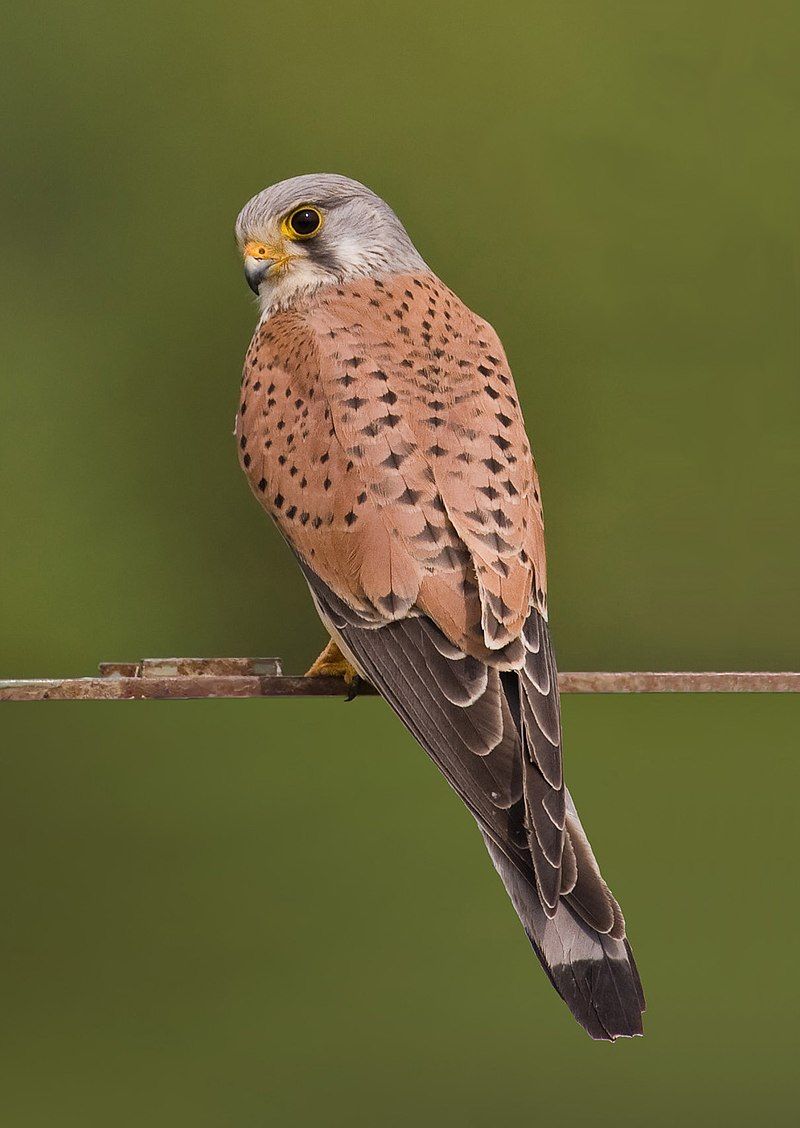
The common kestrel is a type of bird of prey and is part of the falcon family Falconidae. It is found throughout Europe and is commonly known as the European, Eurasian, or Old World kestrel.
The common kestrel is the only species of kestrel found in the United Kingdom, so it is referred to as “Kestrel.” The common kestrel is a medium-sized species of bird of prey and is easily identified by its distinctive, colored plumage.
It has a reddish-brown back, slate-grey head, white underparts, and black-and-white striped tail. Common kestrels have long, hooked beaks and sharp talons for catching prey.
Common kestrels feed mainly on small mammals and insects but also take birds and reptiles. They are typically found in open or semi-open habitats such as grasslands, marshes, and farmland.
The common kestrel is a highly adaptable species and can be seen perching on wires, poles, and trees. Common kestrels play an essential role in their ecosystems, helping to control rodent and insect populations.
They are also popular among birdwatchers, as they can be easily observed and photographed.
| Kingdom | Animalia |
| Phylum | Chordata |
| Class | Aves |
| Order | Falconiformes |
| Family | Falconidae |
| Genus | Falco |
| Species | F. tinnunculus |
11. Great Crested Grebe
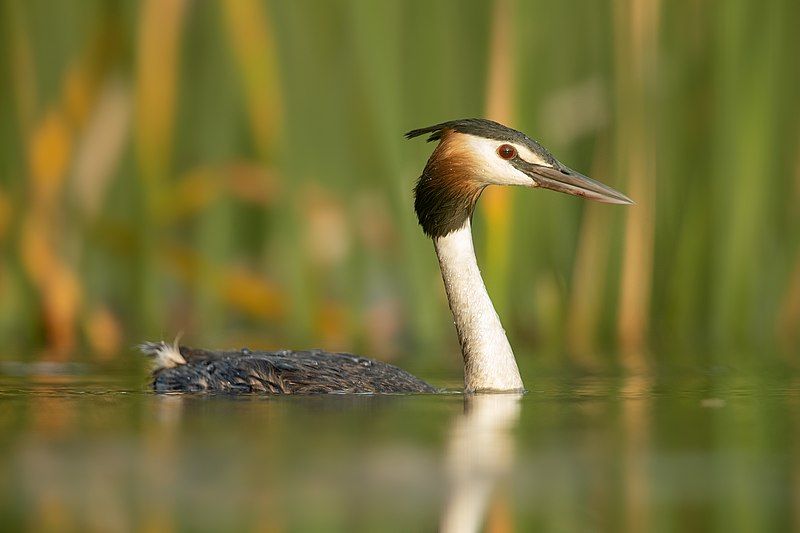
The great crested grebe is a species of bird that belongs to the grebe family. They are found worldwide in freshwater lakes and rivers and are easily identifiable due to their unique physical characteristics.
These birds have a distinctive long and slender neck, a pointed beak, and a thick coat of feathers. The great crested grebe performs an elaborate and impressive courtship display during the breeding season.
This is done to attract a mate and involves a variety of behaviors, including head bobbing, swimming circles around the female, and raising its crest. The male may also present the female with a dead fish or another object as a gift.
This behavior often occurs in pairs and can be quite a sight. After mating, the female will lay her eggs in a nest, usually built on top of floating vegetation in the water.
Both parents incubate the eggs, and the chicks are cared for until they can fend for themselves. The great crested grebe is an essential species in the ecology of freshwater ecosystems and is a vital part of the food chain.
| Kingdom | Animalia |
| Phylum | Chordata |
| Class | Aves |
| Order | Podicipediformes |
| Family | Podicipedidae |
| Genus | Podiceps |
| Species | P. cristatus |
12. Little Grebe
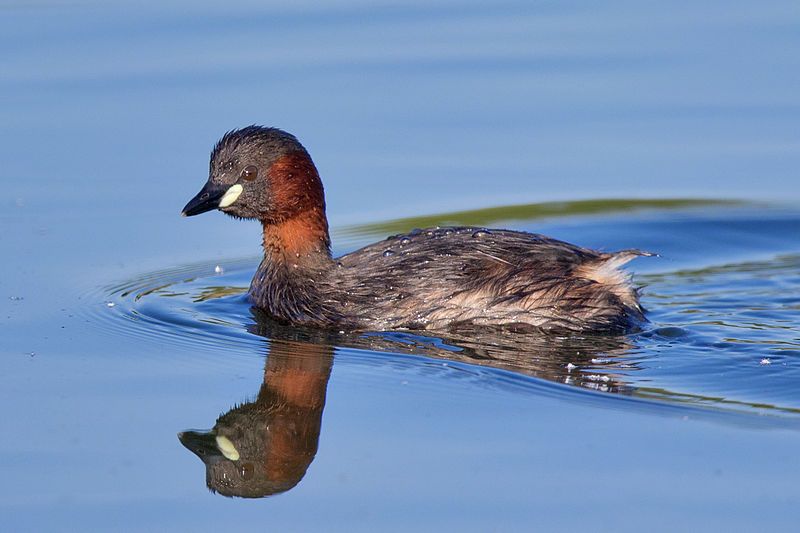
The little grebe, also known as dabchick, is a species of water bird part of the grebe family. Its scientific name, takhus ruficollis, is derived from Ancient Greek and Latin.
The genus name, thus, the Ancient Greek word ” means “fast,” and “b,apto,” which means “to sink under.”
The s.”cific name, ruficollis, is from the Latin word “Rufus,” meaning g “red,” and the Modern Latin word “Collis,” Collis,”s derived from the Latin word “collum” meaning g “neck.” This .” is a reference to the redneck of the bird.
The little grebe is a small bird usually found near shallow freshwater bodies, such as lakes and ponds. It has a long, thin bill and a short tail. Its back and wings are dark gray, while its underside is light gray. Its head and neck are usually reddish.
It feeds mainly on small fish, insects, and crustaceans. The little grebe is a widespread species in much of Eurasia and parts of Africa. It is a famous bird among birdwatchers as it is easy to identify and often seen in large flocks.
As its name suggests, it is also relatively fast in the water and can quickly dive under the surface to escape predators.
| Kingdom | Animalia |
| Phylum | Chordata |
| Class | Aves |
| Order | Podicipediformes |
| Family | Podicipedidae |
| Genus | Tachybaptus |
| Species | T. ruficollis |
13. Whooper Swan
The whooper swan, also called the common swan, is a large, northern hemisphere species of swan. It is the Eurasian equivalent of the North American trumpeter swan and the type species for Cygnus.
It is a migratory bird, usually seen in the summer from April to August in Northern Europe and Asia. It prefers to live in large, shallow bodies of water. The whooper swan has a distinctive yellow bill and black legs and feet.
It is a giant swan, measuring between 140 and 160 cm in length, and has a wingspan of approximately 200 cm. It is also quite vocal, with a loud, trumpeting call. The whooper swan is a famous bird among birdwatchers due to its size and distinctive features.
It is also hunted for its feathers and used for making feather beds and pillows. The whooper swan is an essential species for conservation, as its population has been declining due to habitat loss and hunting.
| Kingdom | Animalia |
| Phylum | Chordata |
| Class | Aves |
| Order | Anseriformes |
| Family | Anatidae |
| Genus | Cygnus |
| Species | C. cygnus |
14. Red-necked Grebe
The red-necked grebe is a migratory bird found in the northern hemisphere’s temperate regions. It usually inhabits coasts and large lakes during the winter season. The bird prefers to be in calm waters, which are just beyond the waves of the ocean.
During winter, some birds may stay on large lakes, but most will stay near the coast. The red-necked grebe is an aquatic bird whose migratory habits help it survive the cold winter months.
The ocean’s calm waters provide a safe environment for the birds to rest and feed. This particular species is adapted for aquatic life and well suited for its migratory lifestyle.
| Kingdom | Animalia |
| Phylum | Chordata |
| Class | Aves |
| Order | Podicipediformes |
| Family | Podicipedidae |
| Genus | Podiceps |
| Species | P. grisegena |
15. Common Moorhen
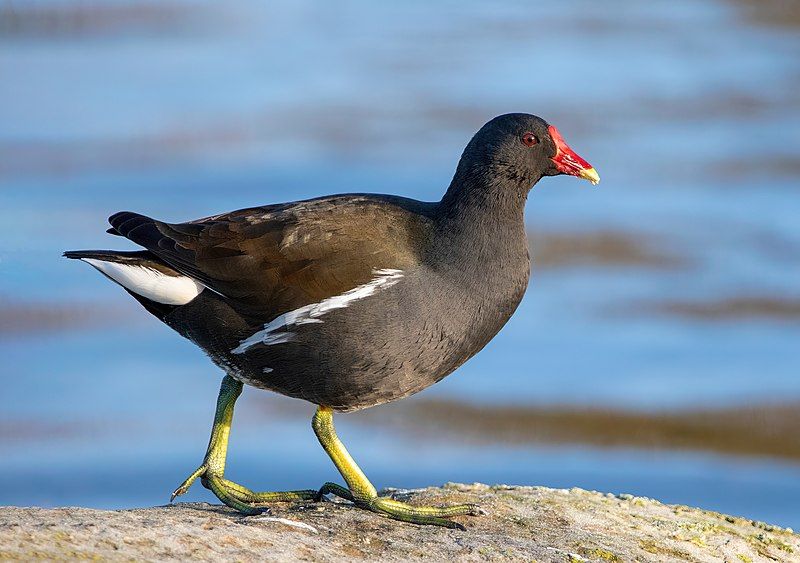
The common moorhen, or the waterhen or swamp chicken, is a species of bird found in the rail family. It is found across many regions in the Old World, such as Europe, Asia, and Africa.
The moorhen is a water-dwelling bird, and it can usually be found near well-vegetated marshes, ponds, canals, and other types of wetlands. It is an omnivorous bird, and its diet consists of a variety of aquatic plants, as well as small animals and insects.
Its primary predators are large birds of prey, and it is also vulnerable to human predation. The moorhen is an integral part of the local ecosystem, as it controls the population of small animals and insects.
| Kingdom | Animalia |
| Phylum | Chordata |
| Class | Aves |
| Order | Gruiformes |
| Family | Rallidae |
| Genus | Gallinula |
| Species | G. chloropus |
16. Nightjars
Nightjars are a bird found in the family Caprimulgidae and order Caprimulgiformes. They are considered medium-sized birds, as they typically measure 18 to 25 inches in length.
Generally speaking, they are active at night or during the crepuscular hours, after dusk and before dawn. One of the most notable features of nightjars is their long wings, which they use to fly silently in search of their prey.
Additionally, they have incredibly short legs and beaks, which is uncommon among most birds. This unique body structure allows them to be well-adapted to their nocturnal lifestyle.
Nightjars have strong legs that help them to land and take off quickly, while their short bills are well-suited to their insectivorous diet. They also have large eyes, which allow them to see in the dark and locate prey.
Overall, nightjars are an exciting species of birds that have adapted to the darkness of night. They are characterized by their long wings, short legs, and concise bills, making them well-suited to their nocturnal lifestyle.
| Kingdom | Animalia |
| Phylum | Chordata |
| Class | Aves |
| Clade | Strisores |
| Order | Caprimulgiformes |
| Family | Caprimulgidae |
17. White Stork
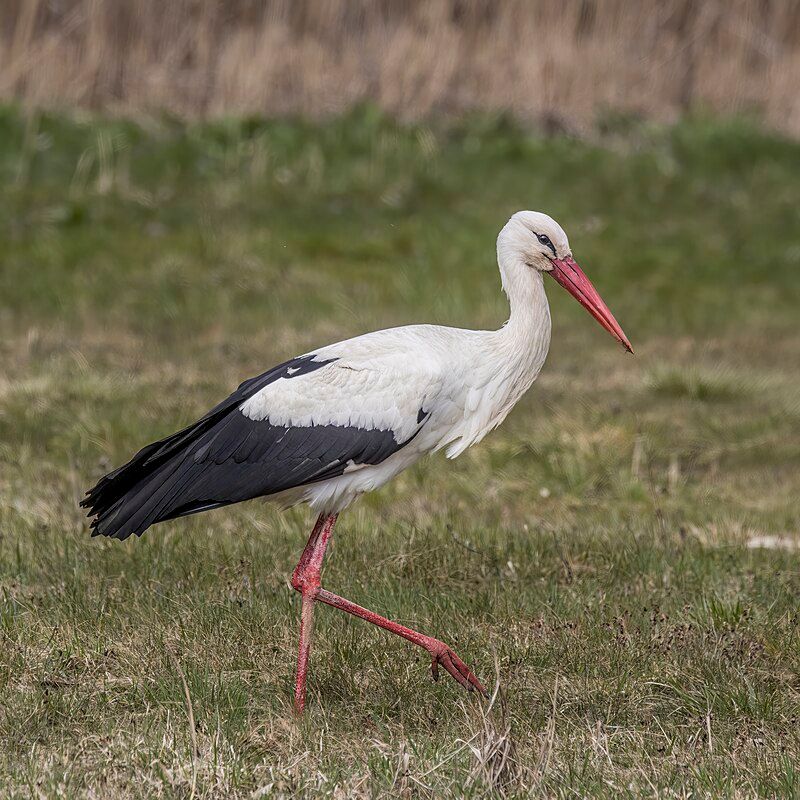
The white stork is a beautiful and unique bird species belonging to the family Ciconiidae. It is a large bird with a wingspan of around 155-215 cm and a body length of 100-115 cm from the beak tip to the end of the tail.
The plumage of the white stork is mainly white, with black on the wings. The legs of the adults are long and bright red, and the beaks are also long and pointed and also a deep red color.
The white stork is a striking bird, and its appearance has made it an iconic species in many cultures. Its wide wingspan makes it an impressive sight in the sky, and its bright red legs and beak make it stand out among other birds.
It is a highly respected species in many countries and a protected species in some areas, making it an essential part of the environment. The white stork is a migratory species, and it can be found in many regions during different times of the year.
During the breeding season, they can be found in Central and Southern Europe, and they migrate to Africa in winter. They can also be found in other parts of the world, including India and the Middle East.
The white stork is a fantastic species and an integral part of the environment. Its unique appearance and behavior make it an interesting species to observe, and its protected status helps to ensure that it is around for many more years to come.
| Kingdom | Animalia |
| Phylum | Chordata |
| Class | Aves |
| Order | Ciconiiformes |
| Family | Ciconiidae |
| Genus | Ciconia |
| Species | C. ciconia |
18. Great Cormorant
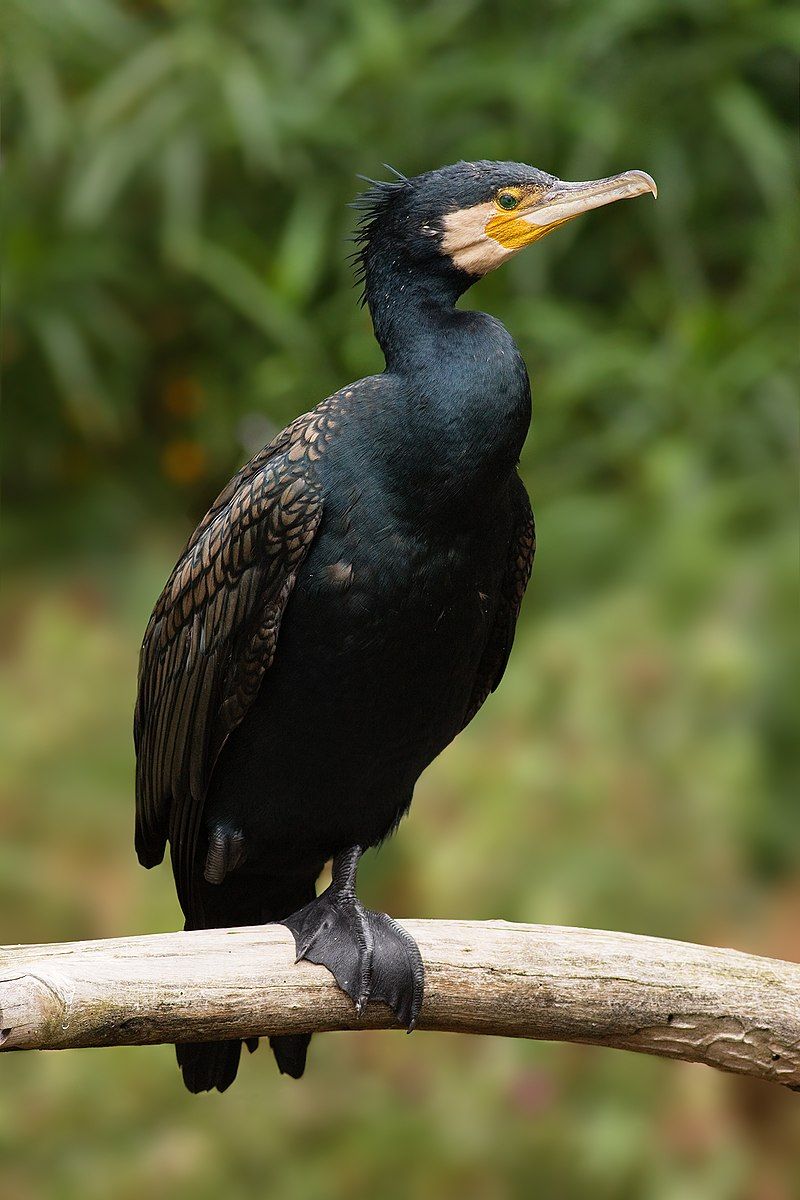
The Great Cormorant is an extremely widespread seabird found throughout the Northern and Southern Hemisphere.
It is known by a variety of different names, such as the “Black Shag” in New Zealand, the “Great Black Cormorant” across the Northern Hemisphere, the “Black Cormorant” in Australia, and the “Large Cormorant” in India.
It is a member of the cormorant family, known for its impressive swimming abilities and ability to dive underwater. The Great Cormorant is a large, black bird with a long, hooked beak and webbed feet.
It is an opportunistic feeder, preying on fish, crustaceans, and other small aquatic creatures. It also feeds on the eggs and chicks of different birds.
The Great Cormorant is a social bird often seen in large groups around coasts and lakes, where it can be seen fishing and nesting in trees.
| Kingdom | Animalia |
| Phylum | Chordata |
| Class | Aves |
| Order | Suliformes |
| Family | Phalacrocoracidae |
| Genus | Phalacrocorax |
| Species | P. carbo |
19. Black-throated Loon
The black-throated loon is a migratory aquatic bird found in the northern hemisphere. It has many names, including the Arctic loon and the black-throated diver. This species is most commonly found breeding in freshwater lakes in northern Europe and Asia.
It is a large bird with a black throat, neck, and white breast. Its wingspan can reach up to 75 centimeters and weighs up to 3 kilograms. It feeds mainly on fish, crustaceans, and aquatic insects.
It migrates to open waters in the North Atlantic or North Pacific during the winter months. It has adapted to colder climates and is quite common in these regions, but its population is decreasing due to habitat loss and water pollution.
Conserving its natural habitats and reducing water pollution is essential to help protect this species.
| Kingdom | Animalia |
| Phylum | Chordata |
| Class | Aves |
| Order | Gaviiformes |
| Family | Gaviidae |
| Genus | Gavia |
| Species | G. arctica |
20. Corn Crake
The corn crake is a species of bird belonging to the rail family. It is native to Europe and parts of Asia, stretching as far as western China.
During winter, the corn crake migrates south to Africa for warmer temperatures and more excellent food supplies. The corn crake is a medium-sized bird with a distinctive long bill and mottled brown plumage.
It is most active at night and is rarely seen during the day. Its diet consists primarily of insects, seeds, and other small invertebrates. The corn crake is an essential species for the conservation of wetland habitats.
It nests in marshes and wet meadows, and its presence is often used to indicate a healthy ecosystem.
The corn crake is also an essential part of the food chain, providing sustenance for predators such as foxes, weasels, and owls. Unfortunately, the corn crake is threatened by habitat loss and degradation.
Wetland drainage and agricultural intensification have significantly reduced its population in many areas. The species is also vulnerable to predation from cats and other animals.
It is a vulnerable species on the IUCN Red List of Threatened Species. To protect the corn crake, preserving and restoring its wetland habitats is essential. This can be done through the protection of existing wetlands and the creation of new wetland habitats.
It is also essential to reduce the impact of human activities on the species’ habitat. Conservation efforts such as these will help ensure the future of the corn crake.
| Kingdom | Animalia |
| Phylum | Chordata |
| Class | Aves |
| Order | Gruiformes |
| Family | Rallidae |
| Genus | Crex |
| Species | C. crex |
21. Tundra Swan
The tundra swan is a species found throughout the Holarctic region, including the Palaearctic and Nearctic.
It is usually considered a single species, but some taxonomists have suggested splitting it into two species: Bewick’s swan of the Palaearctic and the whistling swan proper of the Nearctic.
Bewick’s swan is found in Europe, Asia, and North Africa, while the whistling swan proper is found in North America. Both species are relatively small compared to other swan species and are noted for their distinct whistling call.
They are both migratory birds that breed in the northern latitudes and migrate to milder climates in winter.
| Kingdom | Animalia |
| Phylum | Chordata |
| Class | Aves |
| Order | Anseriformes |
| Family | Anatidae |
| Genus | Cygnus |
| Species | C. columbianus |
22. Black Grouse
The black grouse is a large game bird in the grouse family. It is a sedentary species, meaning it does not migrate and remains in the exact location year-round.
It is found throughout the Palearctic region, which covers most of Europe, northern Asia, and parts of North Africa. The black grouse inhabits moorland and steppe habitats and is often seen near wooded areas.
Its names include northern black grouse, Eurasian black grouse, blackgame, and blackcock. The black grouse is a large bird, typically between 34-40 cm long. The male has black plumage, a white throat and tail, bright red legs, and a yellow eye-ring.
The female is a duller brown, with white stripes on her wings. The black grouse is a sedentary species that builds a grass and twigs nest on the ground.
During the breeding season, it is territorial and will aggressively defend its territory from other males. The black grouse feeds mainly on plants, including buds, leaves, berries, and grasses. It will also eat insects, particularly in the summer.
The black grouse is an essential species in its habitat, as it helps to spread seeds and maintain vegetation.
It is also an important game species for hunters, as it is highly sought-after due to its striking appearance and unique flavor. Overall, the black grouse is a unique and vital species. It is a sedentary species in moorland and steppe habitats across the Palearctic.
It is an important game species for hunters and helps to spread seeds and maintain vegetation. Its impressive plumage and aggressive territorial behavior make it a captivating species to observe.
| Kingdom | Animalia |
| Phylum | Chordata |
| Class | Aves |
| Order | Galliformes |
| Family | Phasianidae |
| Genus | Lyrurus |
| Species | L. tetrix |
23. European Honey Buzzard
The European honey buzzard is a raptor, a bird of prey belonging to the family Accipitridae. It is also known as the pern or common pern, giving it a wide range of names. It is a medium-sized bird with a wingspan of up to one meter and is usually seen soaring.
Its main diet consists of insects, such as bees, and it is also known to feed on small rodents and reptiles. It has a strong, hooked beak and sharp talons, which it uses to hunt its prey.
The European honey buzzard is generally found in open woodland and forested areas throughout Europe and Asia, and it is a common sight in many parts of these regions. It nests in tree hollows or on high branches and tends to migrate south during winter.
| Kingdom | Animalia |
| Phylum | Chordata |
| Class | Aves |
| Order | Accipitriformes |
| Family | Accipitridae |
| Genus | Pernis |
| Species | P. apivorus |
24. Great Tit
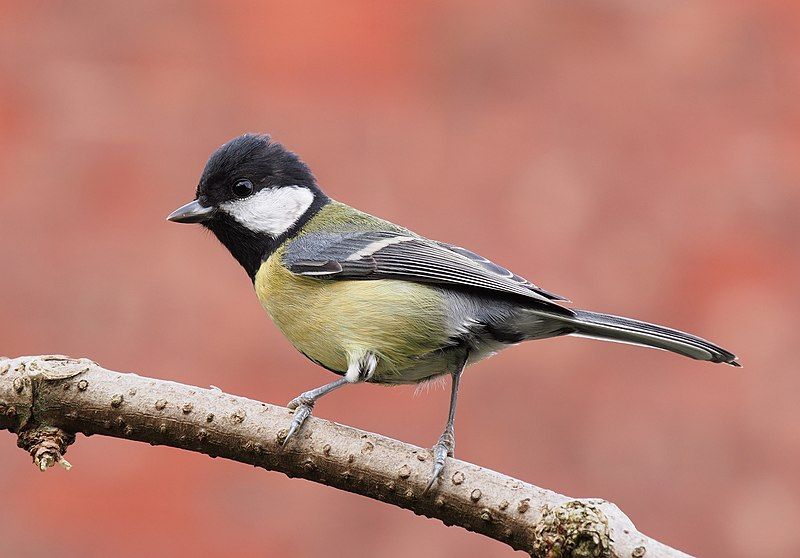
The great tit is a type of bird that belongs to the Paridae family. This species is a passerine, which means it has an upright posture and perches on branches.
It is a widely distributed bird, living in Europe, the Middle East, Central Asia, and east across the Palearctic to the Amur River. This species is also quite common in these regions, making it a species many people can observe in their backyards.
The great tit is a medium-sized bird, measuring about 16 cm in length. It has a grey-black head, a yellow belly, and a white patch on its neck and chest. Its wings are brown-black with white patches, and it has a long tail with white edges.
It has a distinctive black “bib” on its throat, where it gets its name. The great tit is a vocal bird with a vast repertoire of calls and songs. It feeds on various insects, seeds, berries, and nuts.
It can often be seen foraging in shrubs and trees for food. During the winter months, the great tit forms flocks and visits bird feeders. Overall, the great tit is a fascinating bird that is widely distributed throughout Europe, the Middle East, Central Asia, and beyond.
It is a common species that can be easily observed in many places, allowing people to appreciate its beauty and observe its behavior.
| Kingdom | Animalia |
| Phylum | Chordata |
| Class | Aves |
| Order | Passeriformes |
| Family | Paridae |
| Genus | Parus |
| Species | P. major |
Conclusion
Brandenburg’s diverse avian population offers an array of species to delight birdwatchers of all levels.
From the majestic White-tailed Eagle soaring over wetlands to the charming European Goldfinch flitting through forests, each bird contributes to the rich tapestry of Brandenburg’s natural heritage.
Through conservation efforts and responsible ecotourism, these feathered inhabitants can continue to thrive in their native habitats.